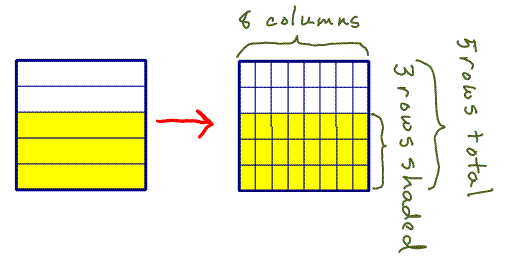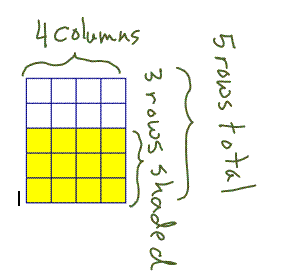Fraction Equivalence using arrays
Using an array to show equivalent fractions is a very flexible tool,
and one that we will see is nicely suited to finding common
denominators. For now, we are just using the arrays to find
fractions that are equivalent to a given fraction. The array
model is best suited to the situation where we need an equivalent
fraction with a larger denominator.
The two main flavors of arrays are ones where a given fraction
representation is subdivided, and one where the fraction representation
looks like it is added on to.
I find subdividing to be the clearer idea. So I will begin with a
representation of a fraction, for example 3/5, and we subdivide it so
that each of the 5 parts is split into the same number of parts.
With a square or rectangular representation of the whole, we get a nice
array when we show the fraction by splitting the whole into 5 parts
with the dividing lines all going the same way, and then make the
subdivisions for the equivalent fractions by adding lines going the
other way:

In this illustration the arrow indicates that the square on the left
was created first, and the square on the right was created from it by
adding dividing lines.
We can find the equivalent fraction by multiplying. The
explanation is one of the following:
Each of the 5 rows is cut into 8
smaller rectangles, so there are 3 × 8 small rectangles
shaded, and
5 × 8 small rectangles in 1 whole.
The shaded part is 3 rows high and 8 columns wide, so it includes 3
× 8
small rectangles, and the whole is 5 rows high and 8 columns wide, so
it consists of 5 × 8 small rectangles.
In either case, we say that clearly the same shaded portion shows both
3/5 (the obvious fraction before adding the dividing lines) and 24/40
(the obvious fraction after adding the dividing lines.
The other way of doing this is to begin with a rectangle that shows our
base fraction, I'll use 3/5 again here, along one side, and is some
convenient length along the other side.

We then note that the shaded area represents both a simpler fraction
(the one if we consider only the rows), and a more complex fraction (if
we consider each of the squares). In the case of the simpler
fraction, we note that 3 rows out of 5 rows are shaded, so the shaded
portion represents 3/5 of the whole. We can also use
multiplication to find the number of shaded squares and the number of
squares in the whole.
The shaded part is 3 rows high and 4
columns wide, so it includes 3 × 4
small rectangles, and the whole is 5 rows high and 4 columns wide, so
it consists of 5 × 4 small rectangles.
Alternately, one could explain that there are 3 shaded rows, and there
are 4 squares in each row, so there are 3 × 4
small squares that are shaded. Likewise, there are 5 total rows,
and there are 4 squares in each row, so there are 5 × 4
small squares in the whole.
Either way, the diagram shows a fraction of 12/20 squares shaded.
In both cases, we have a model that clearly has a way of subdividing
larger pieces into smaller pieces, and multiplication can be used to
figure out the new number of pieces. Numerically, we represent
what we have done in this last example as:

Later, in algebra, we will change this notation slightly to

(A few of you may have fallen into bad habits in high school: notice
that both of these notations have 4 shown twice: once in the numerator
and once in the denominator!)
Simplifying fractions is more difficult to model as an array, because
one
must go backwards. An array version of the simplifying
question might ask: 12 out of 20 squares are yellow. Can you
arrange the squares into a rectangle, where the 12 squares are a
smaller rectangle whose width is the same as the whole rectangle?
Phrased this way, there is a lot of guessing and checking that would
need to be done in order to ever solve the problem. The way we
make simplifying fractions more transparent is to understand the
multiplicative process and relationship for creating equivalent
fractions, and then to use the multiplicative relationships to create a
process for simplifying fractions.
In the next assignment, you will be asked to show that you understand
this process of using an array to inform a multiplicative way of
finding equivalent fractions. Look back at these
explanations. Make sure that you understand at least one of them
from start to finish. A start to finish explanation includes:
- The labelled diagram
- The explanation showing how the diagram shows both a simpler and
a more complex fractions
- An explanation of how to interpret the diagram using
multiplication to find the more complex fraction
- The numerical notation for using multiplication to convert the
simpler to the more complex fraction.
The script for showing math notation on this page is curtesy of www.chapman.edu/~jipsen/asciimath.html